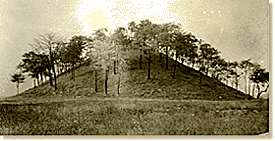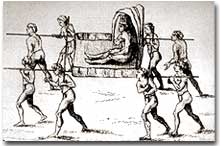From Mississippi Now, "The Natchez Indians," by Jim Barnett -- The Natchez Indians were among the last American Indian groups to inhabit the area now known as southwestern Mississippi.
Archaeological evidence indicates that the Natchez Indian culture began as early as A.D. 700 and lasted until the 1730s when the tribe was dispersed in a war with the French. Their language is now considered to have been a language isolate, not closely related to the other Indian languages of the region.
The Natchez Indians were successful farmers, growing corn, beans, and squash. They also hunted, fished, and gathered wild plant foods.

The ancestors of the Natchez were probably part of the powerful Quigualtam chiefdom encountered by the De Soto expedition in 1542-1543. Due to the spread of European diseases such as smallpox, measles, and bubonic plague, the native population of the Lower Mississippi Valley declined drastically in the century following De Soto’s arrival.
By the late 1600s, the Natchez “tribe” was a confederation of autonomous settlement districts comprised of a remnant of the pre-De Soto population along with Tunican-speaking refugee groups. The burgeoning Indian slave trade initiated by the English in Carolina made it necessary for small groups to band together for protection. The Great Sun, hereditary chief of the Natchez, held a largely ceremonial position of leadership. (Figure 2) Although treated with respect, the Great Sun had no real control over the settlement district chiefs. During the early 18th century, five Natchez settlement districts are recognized: Flour, Jenzenaque, White Apple, Grigra, and Tiou.
Like many Southeastern Indian groups, the Natchez people were divided into two moieties (moitié is a French word meaning “half”). In Native American societies, the two moieties provided each side with marriage partners and performed support services for each other. They were also highly competitive in traditional games such as stickball, which is similar to the modern game of lacrosse. Typically, one moiety was viewed as elder or of higher rank than the other, leading early colonial observers to make comparisons with the class systems in Europe. Moiety membership was determined by heredity through the female line. This system is called matrilineal descent and was also common among other American Indian groups.

Moundbuilding
Moundbuilding was an expression of the complex tribal religion with the mounds serving as bases for sacred buildings. The people of the tribe worked together to construct and maintain the mounds. The type of mounds built by the Natchez, flat-topped ceremonial mounds, shows the influence of moundbuilding cultures to the north in the Middle Mississippi River Valley.
Only a few high-ranking tribal officials lived at the mound centers on a permanent basis. The people of the tribe, living dispersed over a wide area on family farms, gathered at the mound centers periodically for social and religious activities.

The Grand Village of the Natchez Indians in Natchez, Mississippi, was the site of the Natchez tribe’s main ceremonial mound center during the early period of French colonization in the Lower Mississippi River Valley. Construction of the mounds at the Grand Village was done in stages, probably beginning in the 13th century. (Figure 3)
The Natchez Indians also constructed Emerald Mound, near Natchez on the Natchez Trace Parkway. Archaeological evidence indicates that Emerald Mound may have been the main ceremonial mound center for the tribe before that status was shifted to the Grand Village sometime prior to the arrival of French explorers in the late 1600s.

Arrival of the Europeans
The first documented historical contact with the Natchez Indians occurred in March 1682 when the Rene-Robert Cavelier, Sieur de La Salle expedition descended the Mississippi River. Following La Salle’s meeting of the Natchez Indians, French and English explorers, priests, and military personnel made frequent visits to the Natchez area. The French established Fort Rosalie at Natchez in 1716 as the nucleus of a colony. Over the next thirteen years, the French colony at Natchez grew. However, disputes and misunderstandings between the French and the Natchez resulted in a series of conflicts.
The situation worsened as the Natchez became caught up in the 18th-century struggle between England and France for control of North America. By the 1720s, English agents were successful in turning a significant portion of the Natchez tribe against the French.
In November 1729 the Natchez Indians rebelled against the French colony, resulting in a war between the Natchez and the French. The Natchez Indians ultimately lost the war and were forced to abandon their homeland. Following their defeat at the hands of the French, many Natchez refugees joined other tribes, including the Chickasaws, Creeks, and Cherokees. Today, Natchez Indian descendants live in the southern Appalachian Mountains area and in Oklahoma. (source: Mississippi Now)




No comments:
Post a Comment